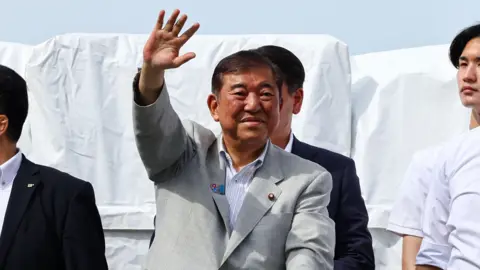
Tokyo correspondent
 Getty Images
Getty ImagesExit polls from a key election in Japan project the ruling coalition is set to lose its majority, putting the country’s Prime Minister Shigeru Ishiba under immense political pressure.
Voters headed to the polls earlier on Sunday for the tightly-contested election, being held amid public frustration over rising prices and the threat of US tariffs.
Earlier polls had indicated that Ishiba’s Liberal Democratic Party (LDP) and its junior partner Komeito were at risk of losing their majority, having already lost their majority in Japan’s more powerful lower house.
The coalition needs 50 seats to retain control of the 248-seat upper chamber – with an exit poll from public broadcaster NHK projecting them to win between 32 and 51.
NHK projected it “may be difficult for the ruling coalition to maintain their majority”.
Half of the seats in the upper chamber were being voted on in Sunday’s election, with members elected for six-year terms.
If the coalition takes home less than 46 seats, it would mark its worst performance since it was formed in 1999.
Ishiba’s centre-right party has governed Japan almost continuously since 1955, albeit with frequent changes of leader.
The expected result underscores voters’ frustration with Ishiba, who has struggled to inspire confidence as Japan struggles against economic headwinds, a cost-of-living crisis and trade negotiations with the United States.
Many are also unhappy about inflation – particularly the price of rice – and a string of political scandals that have beleaguered the LDP in recent years.
The coalition’s loss would critically undermine its influence over policymaking, opening it up to major compromises with opposition parties, and could prompt Ishiba to quit less than a year after he was elected.
The last three LDP premiers who lost a majority in the upper house stepped down within two months, and analysts had predicted that a significant loss in this election would yield a similar outcome.
This would open the field for a potential run at the leadership by other notable LDP members, including Sanae Takaichi, who finished second to Ishiba in last year’s general election; Takayuki Kobayashi, a former economic security minister; and Shinjiro Koizumi, the son of former Prime Minister Junichiro Koizumi.
In any case, a change of leadership within the ruling party would almost certainly unleash political drama and destabilise Japan’s government at a pivotal moment in US-Japan trade negotiations.
 Reuters
ReutersSupport for the ruling coalition appears to have been eroded by candidates from the small, right-leaning Sanseito party, which drew conservative votes with its “Japanese First”, anti-immigration rhetoric.
Sanseito first gained prominence on YouTube during the Covid-19 pandemic, spreading conspiracy theories about vaccinations and a cabal of global elites.
The fringe party’s nativist rhetoric widened its appeal ahead of Sunday’s vote, as policies regarding foreign residents and immigration became a focal point of many parties’ campaigns.
Going off the NHK exit polls, it is on course to win seven seats.
Famous for its isolationist culture and strict immigration policies, the island nation has experienced a record surge in both tourists and foreign residents in recent years.
The influx has further driven up prices for Japanese people and fuelled a sentiment among some that foreigners are taking advantage of the country, aggravating discontent.
Against that same backdrop, Ishiba last week launched a task force aimed at tackling “crimes or nuisance behaviours committed by some foreign nationals”, including those relating to immigration, land acquisitions and unpaid social insurance.





